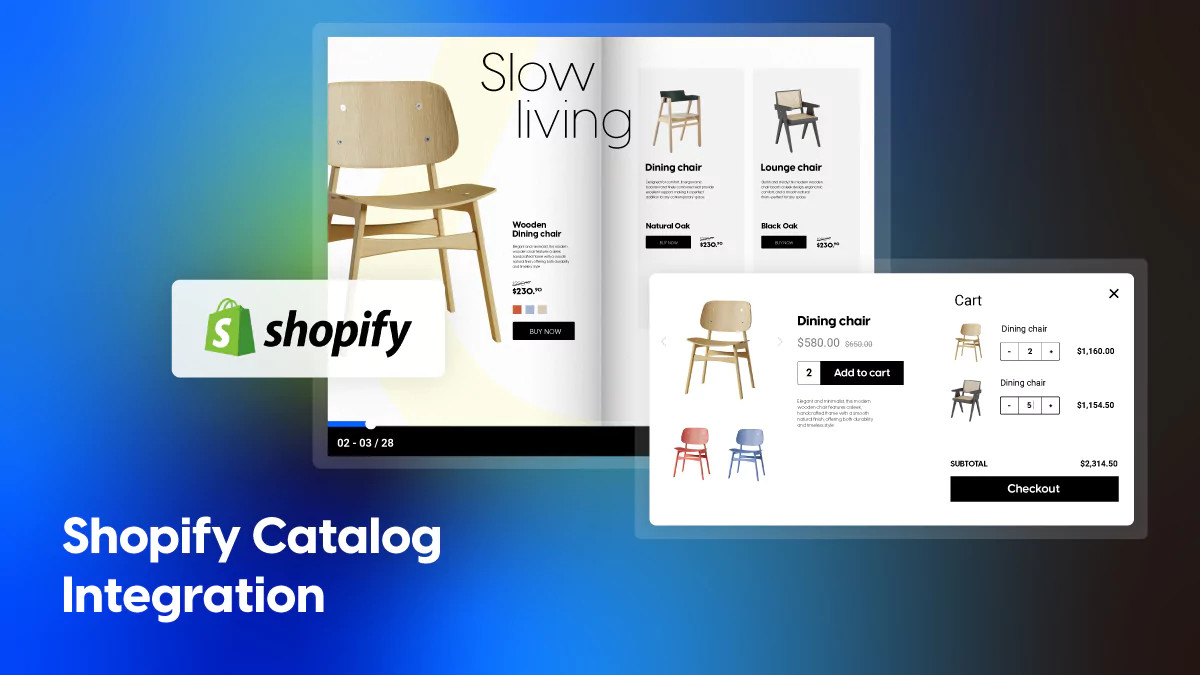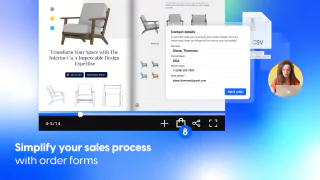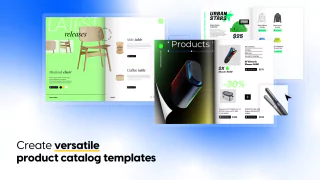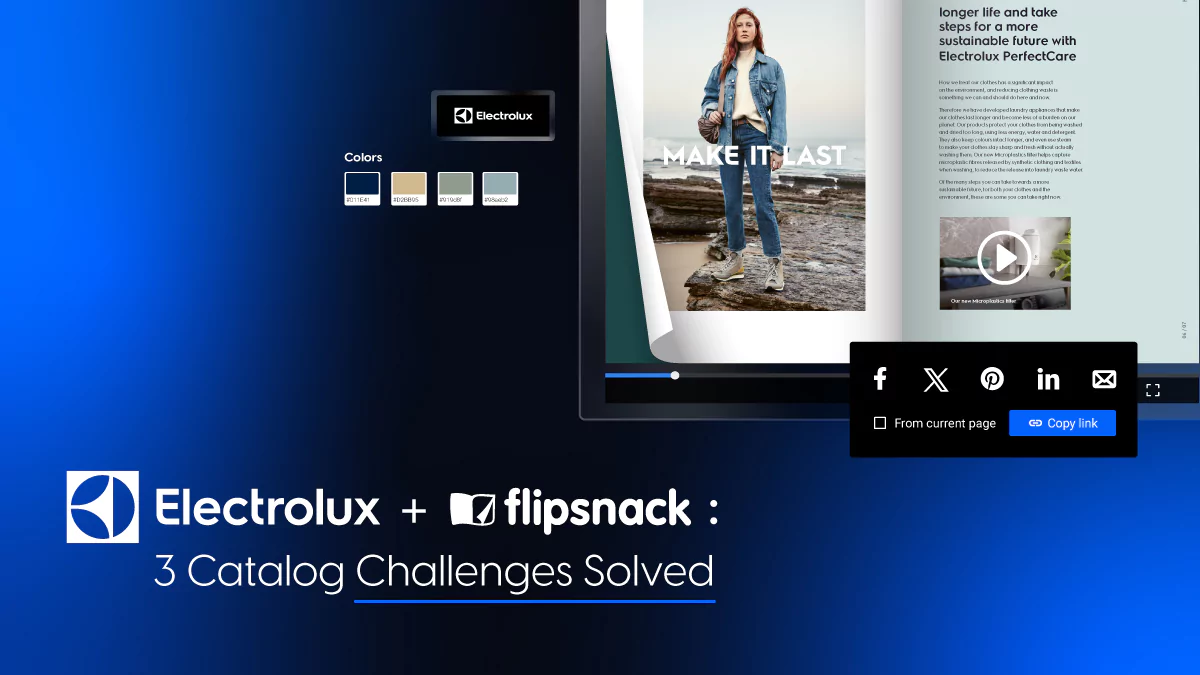Increase Sales with Flipsnack’s Shopify Catalog Integration
Last updated: February 28th, 2025
Digital catalogs are more than just product showcases They’re powerful sales tools designed to streamline ordering processes, capture attention, and drive sales. With Shopify catalog integration for wholesale and retail, businesses can automate product syncing directly from their eCommerce systems, ensuring that inventory stays accurate in real time.
Plus, buyers can browse products, engage with interactive elements like videos, photo slideshows, buy buttons and clickable links to view detailed information, and even place orders.
Flipsnack’s digital catalogs can easily be integrated with Shopify, making the buying process faster, more engaging, and more efficient. By leveraging our Shopify catalog integration, businesses can expand their sales and marketing efforts and offer customers the seamless shopping experience they now expect.
In this article, I’ll cover the benefits of catalog integration with Shopify and how interactive digital catalogs can enhance your sales and marketing efforts. I will also guide you through the step-by-step process of setting up Flipsnack’s Shopify catalog integration.
Table of contents
- What is a digital catalog?
- Choose Flipsnack for your digital catalog integration with Shopify
- How to integrate Shopify with a digital catalog in Flipsnack
- Digital catalogs: a powerful tool for both B2C and B2B
- Benefits of using the catalog integration with Shopify
- Frequently asked questions about the Shopify catalog integration
- Nothing beats an effortless shopping experience
But first, let’s talk about a few fundamentals.
What is a digital catalog?
Online catalogs are the digital representation of printed catalogs. So add your PDF product catalog document that you’ve prepared for printing, and transform it into a digital catalog by using an online catalog maker app like Flipsnack. Simply upload your PDF catalog and transform it into a professional, digital catalog with a 3D page-flip effect.
But this is not the only way to get yourself a digital catalog. You can always start the process from scratch or use a variety of catalog templates. Even though there are some catalog maker apps available, make sure to always go for the most professional one.
Digital catalogs offer an engaging and professional way to showcase products. They can also act as a secondary online store, allowing customers to browse and purchase directly from the catalog, expanding sales channels for businesses.

Increasing your sales with a product catalog is not so difficult when you have all the right ingredients to achieve a professional catalog. The most important aspect though is to offer your buyers and resellers a fantastic and smooth shopping experience when they discover your eCommerce catalog. That’s why choosing a professional tool right from the start is crucial, as it will be easier to set up every detail in one place.
So look for an online catalog maker tool that offers you:
- Shopping features for a seamless shopping experience
- Interactive elements to make your customers’ journey entertaining
- Catalog integration with Shopify so you can sell more and expand your audience
These are the requirements that you need to search for when deciding on what catalog maker tool to use.
Let’s quickly look at some of Flipsnack’s key advantages regarding the Shopify catalog integration, benefits that set us apart from the competition.
Choose Flipsnack for your digital catalog integration with Shopify
Even though other catalog maker tools provide the Shopify catalog integration, Flipsnack takes things to the next level.
Here’s why you should choose Flipsnack for your Shopify digital catalog integration:
- Smooth Shopify integration that allows direct purchases from the catalog.
- Real-time updates for the products’ availability, prices, and promotions.
- Enhanced interactivity through photo slideshows, videos, pop-up frames, etc.
- Professional branding by adding a logo, color palette, fonts, and a personalized URL.
- Advanced analytics by checking views, clicks, time spent, and more.
- Mobile-friendly & accessible catalogs with a responsive design on any device.
These are only a few reasons why Flipsnack’s eCommerce product catalog is the right solution for your business.
Now, let’s see how to set up the Shopify catalog integration in Flipsnack.
Integrate your Shopify store into your digital catalogs
To be able to set the catalog integration with Shopify, you’ll need to have a website. Also, make sure to upload a PDF and turn it into a digital catalog in Flipsnack. You can either start the process from scratch or simply choose one of our many templates. Basically, by doing this you have already prepared your digital catalog for the Shopify integration and should be on track to compete with the top shopify stores.
I would highly encourage you though to try our Flipsnack templates if you don’t already have a PDF document. These templates are made by our professional designers. And every tiny detail within these templates has a special role and place. Even the colors, images’ size, font style, and so on, it’s thought about with great attention so that the final result is a stunning digital catalog.

How to integrate Shopify with a digital catalog in Flipsnack
Step-by-step guide on how to set up the catalog integration with Shopify in Flipsnack:
- Head over to your Shopify website, and you’ll see a category called the Buy button. That’s what we want to activate, so open it and then click on Create a Buy Button.
- Now you’ll have two options. By choosing the Product Buy Button you’ll be able to add products to the cart individually. But if you think the Collection Buy button will work better for you, then try that one.
- You’ll see a list of all your products, so simply select the ones you want to add a Buy Button for in your digital catalog.
- The following step is to customize the product’s appearance. Play around a bit to see what you’d like the final result of your product’s design to look like. And when you’re happy with the final result, click on Next.
- It’s time to Copy the code. So simply click on it in order to copy all the content of the popup frame we previously created.
- Now go to Flipsnack, select your digital catalog, and open it in our Design Studio. Go to the page where you want to add the Popup frame and from the sidebar, choose the Link category. Select the Popup frame.
- Add the Popup frame onto the desired product and simply paste the code we’ve copied earlier into the Popup frame code to activate the Add to cart functionality.
- Click on Preview to make sure the popup opens with all the right information, and that’s it. You’re settled!
Here’s also a video that might come in helpful when you go through these steps. So make sure to check it out.
Add Shopify cart in your catalogs
You can also make this entire process faster by using the popup frame automation. This might come in great help especially if you have lots of products that you want to introduce in your digital catalog. Take a look at both options and choose the one that suits your needs best.
Now let me introduce you to our client Electrolux.
Electrolux Group is a leading global appliance company that has shaped living for the better for more than 100 years. They reinvent lifetime taste, care and wellbeing experiences for millions of people. Also, they’re striving to be at the forefront of societal sustainability through their solutions and operations.
Take a look at one of their digital catalog examples here:
They’re mainly interested in delivering high-quality, interactive catalogues to keep them updated with their novelties and innovations.
Read their full customer story to discover how Flipsnack helped them leverage digital catalogs for their business.

Digital catalogs: a powerful tool for both B2C and B2B
As businesses adapt to the growing demand for shoppable digital catalogs, interactive product experiences have become essential assets for B2C and B2B. With digital catalogs, customers can do more than just browse. They can zoom into product images, explore detailed descriptions, and make purchases directly from clickable links and shoppable pages.
Explore the shopping experience of connecting your digital catalog to your Shopify store for direct checkout:
By combining Shopify integration and real-time syncing, businesses ensure that product details, prices, and inventory levels automatically stay up to date. This will save time for both marketing teams and eCommerce managers. This increasing reliance on automation in eCommerce not only enhances accuracy but also empowers marketing teams to build multichannel sales strategies that work across social media, email campaigns, and websites.
The shift towards interactive product experiences also supports enhanced cross-platform selling strategies, allowing businesses to meet customers wherever they shop. Whether customers access a catalog via multichannel sharing through email newsletters, social media posts, website embeds, or even QR codes, each touchpoint becomes a sales opportunity.
And because digital catalogs are mobile-friendly by design, customers enjoy a seamless experience on any device. For forward-thinking businesses, embracing digital catalogs means reducing printing costs, simplifying updates, and creating more engaging, data-driven content. One that doesn’t just showcase products, but actively drives conversions.
Branding and data insights also play a major role. From white-labeling and URL branding to fully personalized layouts and themes, businesses can create catalogs that match their corporate identity. All this while still delivering an interactive digital catalog.
Behind the scenes, built-in statistics play an essential role for showing exactly which products and pages attract the most attention. These are valuable insights for sales and marketing teams to know how to optimize their digital catalog strategy better.
As you’ve seen, digital catalogs become a data-rich resource that enhances Shopify integration and directly supports conversion-focused strategies.
Benefits of using the catalog integration with Shopify
Since we’ve already established that more people buy digitally, eCommerce brands need to keep up with trends and try online catalogs to provide an inspiring product experience to potential buyers.
Using the catalog integration with Shopify, you’ll be able to offer your customers a seamless shopping experience. Just add shopping features designed to ease yours and their life when hitting that Add to cart or Buy button in your digital catalog.
They won’t settle for anything less once they’ve seen and worked with you through a professional, customer-oriented digital catalog. And now that you’ve seen what a catalog integration with Shopify looks like, you can understand why.
The benefits of using digital catalogs with the Shopify integration:
- Expand your eCommerce efforts
- A better end-to-end business integration
- Increase orders and sales with shopping features
- Allow you to have on-brand catalogs, bespoke pricings, and offers
Now let me give a bit more context about each benefit.
1. Expand your eCommerce efforts
Let’s be honest. A bigger market drives more sales. That’s precisely why retailers and wholesalers have to meet their potential customers where they are. Increasing your digital presence and brand awareness should be one of the main key points in your marketing strategy.
And don’t forget the giant mass of online retailers that already know and use the power of digital presence. Not only that, but they invest thousands of dollars to get as visible as possible. By using the catalog integration with Shopify you’ll have a professional-looking catalog that will enable your customers to get the right information about your product and easily add them to the cart.
Also, it will be easy to send it over to your clients as a direct link. Or try other public sharing options like sending it via email, embedding it on your website, or sharing it on your social media platforms.
There are no limits to how many people you can send your catalog to. And the whole process of sharing happens in just a few seconds. So establish a strong online presence and help your business move at a faster pace!
2. A better end-to-end business integration
One great benefit online catalogs offer is the possibility to integrate your retail management system (RMS) into your catalogs, such as your Shopify store. Connecting your Shopify store to your digital catalog will help you maintain an up-to-date and accurate product catalog with all the information you have on your website.
You also have the automation option that digital catalogs have – not all catalog maker apps have that, but the best ones do. And you should always choose the most professional tool available. By using the automation feature, you’ll simplify the production of your catalogs by connecting your digital catalog to various data sources. Just upload your CSV or XLSX files or connect your online catalog to a Google spreadsheet, and you’ll be able to automate tasks that you did manually.
With digital catalogs, you reduce the human error element, your updates will happen quickly, and your data information will always be on point.
Also, by checking Flipsnack’s statistics, businesses can see their digital catalogs’ performance like views, clicks, time spent, and more data. This way, marketing teams can better analyze their customers’ behavior and optimize future catalogs on concrete data.

3. Increase orders and sales with shopping features
Integrating your Shopify store into your digital catalog will get you a special Shopify buy button. Through it, your customers will be able to add products to the cart right from your digital catalog. They’ll also be able to select their desired products, and even the quantity for each item. The only time they will have to leave the catalog is to do the checkout. All these will help to offer a seamless shopping experience for your customers – which is the ultimate retailers’ and wholesalers’ goal, right?
Digital catalogs provide the perfect opportunity to easily sell your products by displaying them in an engaging way. You can also add videos, photo slideshows, tags, audio, and many more. They also provide you with some amazing shopping features such as buy buttons, price tags, and the option to add products directly to the cart.
The catalog integration with Shopify will help you get your customers further down the sales funnel. A professional-looking catalog and a seamless shopping experience will impress your customers and determine them to take action and hit that buy button.
4. Have on-brand catalogs, bespoke pricings, and offers
Having catalog integration with Shopify can be the next big branding element you can use for your eCommerce strategy. Especially if you want your product catalog to be an extension of your website. You’ll be able to easily reflect your website’s style and vibe in your product catalog, and also sell. It will also be much easier for you to maintain brand consistency throughout your catalog-making process. This will also help to increase brand awareness and help your customers recognize your company among the others.
Another great benefit of having the Shopify integration is that you can set up special pricing and offers. These will be automatically updated in the digital catalog. So whenever you have ongoing sales, new apparel, or holiday discounts, the Shopify integration will update your catalog.
So keep your customers informed about everything happening on your website and let it be also reflected in your digital catalog.

Frequently asked questions about the Shopify catalog integration
For enhancing catalog integration with Shopify, using apps like Shopify’s Product Reviews to add customer feedback directly to your products, or apps that offer advanced inventory management and personalization can significantly enhance the user experience. The Shopify App Store offers a variety of apps designed to complement catalog functionality.
Common challenges include syncing inventory in real-time and ensuring that product information is consistent across the catalog and Shopify store. Addressing these challenges typically involves using integration tools. These will automatically update product details and stock levels, reducing manual oversight and minimizing errors.
Yes, you can sync your Shopify store with an interactive catalog. This allows your product information like images, descriptions, prices, and inventory to automatically update in the catalog whenever changes are made in Shopify.
Nothing beats an effortless shopping experience
Catalog integration with Shopify is more than just a convenient feature. It’s a powerful way for businesses to streamline product management, enhance the buying experience, and drive more sales directly from their digital catalogs. By combining Flipsnack’s interactive catalogs with Shopify syncing, your team can create fully branded, shoppable catalogs that will keep product information accurate and your customers engaged across multiple channels.

If your business relies on product catalogs to showcase offerings and drive sales, integrating Flipsnack with Shopify is the smartest step forward. From automated product updates to embedded purchase links and in-depth performance tracking, this solution helps you save time, boost conversions, and elevate your marketing strategy.
Ready to transform your catalogs into high-converting sales tools? Sign up for Flipsnack today and experience the power of interactive catalogs integrated with Shopify.





